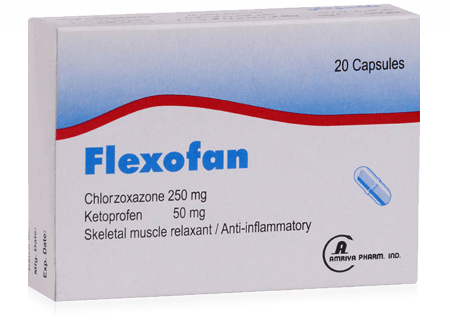
Flexofan Capsules
Company name :
Amriya Pharmaceutical ind.
Trade name :
Flexofan Capsules
Generic Name :
Ketoprofen
Chlorzoxazone
Composition :
Each capsule contains:
Active Ingredients:
Ketoprofen 50 mg
Chlorzoxazone 250 mg
Inactive Ingredients:
Croscarmellose sodium. Calcium phosphate tribasic (anhydrous). Magnesium stearate. PVP k25 Sodium hydroxide
Pharmaceutical Form :
Oral capsules
Pharmacology :
ChlorzoxlfZone IS a centrally acting skeletal muscle relaxant wittrs edative properties. It is claimed to inhibit muscle spasm by exerting an effect primarily at the level of the spinal cord and subcortical areas of the brain. Its effects begin within an hour of an oral dose and last for 3 to 4 hours. Ketoprofen. a propionic acid derivative is an NSAID.
Pharmacokinetics :
Chlorzoxazone is readily absorbed from the gastrointestinal tract and metabolized in the liver. Chlorzoxazone is primarily excreted in urine. Its half life is 1.1 hours. Ketoprofen is readily absorbed from the gastrointestinal tract; peak plasma concentrations occur about 0.5 to 2 hours after an oral dose. Ketoprofen is 99% bound to plasma proteins and substantial concentrations of drug are found in the synovial fluid. The elimination half-life in plasma is about 1.5 to 4 hours. Ketoprofen is metabolised mainly by conjugation with glucuronic acid. and is excreted mainly in the urine.
Indications :
Flexofan is used as an adjunct in the symptomatic treatment of painful muscle spasm associated with musculoskeletal conditions.
Flexofan is also used in the treatment of pain and mild inflammation in rheumatic disease and othermusculoskeletal disorders, and after orthopaedic surgery and acute gout.
Dosage and Administration :
1 capsule 3 – 4 times daily.
The total dose should not exceed 6 capsules daily in divided doses.
Contraindications :
– Hypersensitivity to any of the components.
– Bronchospasm
– Peptic ulceration
– Severe renal insufficiency
Side effects :
Drowsiness, fever, headache, nausea, vomiting, stomach cramps, rash and pancreatitis. Photosensitivity reactions and cross-sensitivity to other drugs, notably bezafibrate, ciprofibrate and fenofibrate.
Drug Interactions :
The C.N.S effect of chlorozoxazone may be enhanced by alcohol and C.N.S depressants. Disulfiram reduced plasma clearance of chlorzoxazone. Ketoprofen is highly protein bound. In theory, interaction is possible following the concomitant use of other protein-
bound drugs, for example, anticoagulants, sulfonamides, and hydantoins. The mode of action of non-steroidal anti-inflammatory
drugs in causing a hazardous interaction with methotrexate
is not certain, but may be via inhibition of the tubular secretion of methotrexate. Ketoprofen slightly inhibits the sodium diuresis induced by furosemide. Ketoprofen may reduce the anti -hypertensive effect of [3-blockers.
Lithium intoxication has been reported as a result of concurrent administration of ketoprofen. Probenecid increases the concentration of ketoprofen and of ketoprofen conjugates.
Pregnancy and Lactation :
The effect of administration of the drug during pregnancy or lactation is unknown.
Precautions and Warnings :
Serious (including fatal) hepatocellular toxicity has been reported rarely in patients receiving chlorzoxazone. The mechanism is unknown but appears to be idiosyncratic and unpredictable. Factors predisposing patients to this rare event are not known. Patients should be instructed to report early signs and/or symptoms of hepatotoxicity such as fever, rash, anorexia, nausea, vomiting, fatigue, right upper quadrant pain, dark urine, or jaundice.
Chlorzoxazone should be discontinued immediately and a physician consulted if any of these signs or symptoms develops. Chlorzoxazone use should also be discontinued if a patient develops abnormal liver enzymes (e.g. AST, ALT, alkaline phosphatase, and bilirubin). The concomitant use of alcohol or other central nervous system depressants may have an additive effect.
Cardiovascular Risk :
– NSAIOs may cause an increased risk of serious cardiovascular thrombotic events, myocardial infarction (Ml), and stroke, which can be fatal. The risk may increase with duration of use. Patients with
cardiovascular disease or risk factors for cardiovascular disease may be at greater risk.
– NSAIOs are contraindicated for the treatment of perioperative pain in the setting of coronary artery bypass graft (CABG) surgery.
Gastrointeslinal Risk :
NSAIOs cause an increased risk of serious gastrointestinal adverse events including inflammation, bleeding, ulceration, and perforation of the stomach or intestine, which can be fatal. These events can occur at any time during use and without warning symptoms. Elderly patients are at greater risk for serious gastrointestinal (Gl)
events. Chlorzoxazone may cause drowsiness; patients affected
should not drive or operate machinery. The urine of patients taking chlorzoxazone may be coloured orange or reddish purple by a phenolic metabolite. Chlorzoxazone has been associated with acute attacks of porphyria and is considered unsafe in porphyric patients.
Ketoproten.shnuld.bejrsed with caution in patients with renal or hepatic impairment.
Package :
A carton box containing 2 strips (PVC/ AI), each of 10 hard gelatin capsules + inner leaflet.
Storage :
Store at a temp~”””’e not exceeding 30°C in a dry place.
Produced by :
A AMRIA FOR PMARMACEUTICAL INDUSTRIS
ALEXANDRIA – EGYPT
